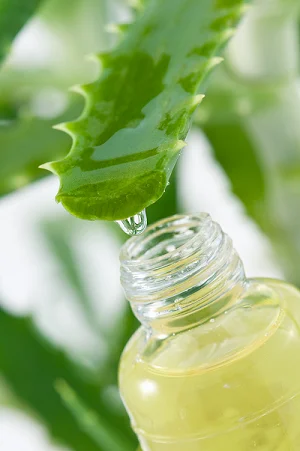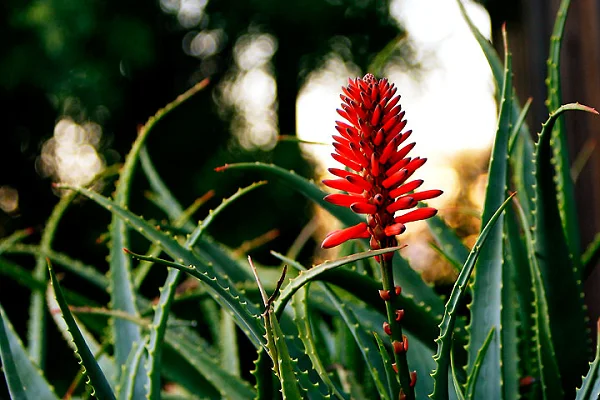Aloe is a perennial herbaceous herbaceous, shrubby or arboreal plant with thick, fleshy elongated leaves at the edges, smooth or toothed, or with thorns gathered in a dense rosette.
In the wild, aloe grows in Africa, South America, the Arabian Peninsula, and is also found in the Mediterranean and India. There are over 300 species of aloe, most of which grow in the wild. The height of some species reaches up to 15 meters. In nature, the conditions are so favorable that aloe blooms. Aloe releases a long arrow from the rosette of its fleshy leaves, at the end of which blooms a flower with tubular petals, very similar to the flowers of knifofiya. The color of the flower can be different – orange, purple, red, yellow. Unfortunately, I have not yet encountered aloe, which grows in a pot and blooms.
Varieties of Aloe
The most popular aloe species Aloe arborescens, Aloe aristata, Aloe dichotoma, (aloe tree species reaches a height of 3 meters), Aloe ngobitensis, Aloe plicatilis, Aloe variegata, Aloe vera.
Aloe – not only a houseplant, but also medicinal Since ancient times, aloe juice is valued by doctors for its healing properties that promote rapid wound healing. And women loved this plant for its ability to maintain healthy skin and rejuvenate it.

Aloe is not only a houseplant, but also a medicinal plant. From time immemorial, aloe juice has been valued by doctors for its healing properties that promote rapid wound healing. And women loved this plant for its ability to maintain healthy skin and rejuvenate it.

Medicinal properties of Aloe
In folk medicine, aloe juice is found in many recipes. Pharmacists make tablets, drops, ointments and creams based on aloe vera juice (Aloe vera). Aloe is used internally: as a laxative, in the treatment of gastric diseases, eye diseases, digestive organs. Externally used in the form of ointments and juices, in its pure form for the treatment of burns of various degrees, treat wounds on the skin that do not heal well. Aloe is also used as an antiseptic and as an antibacterial agent. Aloe juice is prepared independently, it should be used immediately so that it does not lose its healing properties.
But even such a useful product as aloe juice should be used with caution. Consult a doctor before use.

The healing properties of aloe are widely used in cosmetology, in particular in creams to which concentrated aloe juice is added. This cream is used for skin and body care.
Caring for Aloe
Caring for aloe is not difficult. It is enough to choose the right place, water, fertilize and this medicinal plant will grow well and, who knows, maybe bloom.
Air temperature
In winter, at rest of the plant, the air temperature should be up to 14 degrees. In summer – moderate.
It can be taken out into the fresh air, but be sure to shade. A sharp change in temperature day and night will not hurt, but, on the contrary, I really like it.
Brightness of light
Prefers diffused light, grows best in the south. Eastern and Western window sills. It can grow in direct sunlight, on the south side of the house, in the spring you need to gradually accustom the plant to direct sunlight to prevent sunburn. In winter, aloe is dormant, but the leaves continue to undergo physiological processes, so it is best to choose the brightest place.
Watering and humidity
It is best to use soft water. In winter, watering is rare.
Starting in the spring, watering is increased as the topsoil dries. If water flows out of the drain hole very quickly during watering, leave for half an hour and pour out excess water. No spraying required.
Soil and transplant
Land can be bought in garden centers or flower shops, it is better to choose soil for succulents and cacti. And you can prepare the soil mixture yourself. In proportions: 2 parts soil: 1 part deciduous soil, 1 part humus, 1 part coarse sand, also add charcoal, sphagnum, perlite and vermiculite. Soil acidity should be low. Young aloes are transplanted every spring, adults every 2-3 years.
After transplanting, add water and put in a shady place for adaptation for 4 days.
Reproduction of aloe
Propagated by aloe seeds, cuttings, basal shoots.
Seeds are sown in the spring in wide containers, pouring on the ground. Water with a sprayer as the soil dries. After emergence and in the phase of 3-4 leaves dive into small single pots.
Cuttings can be propagated all year round, but it is better in the spring, because the cuttings do not like the sun and heat. Cuttings and top shoots are cut with a sterile tool and dried – 2-3 days. Plant in moist sand to a depth of 1 cm, after 1-2 weeks transplanted into pots with soil.
Pests and diseases
Aloe pests do not threaten. Aloe, with improper care, can get root or dry rot.

